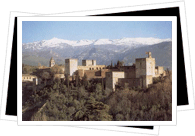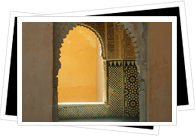 Early Granada History
Early Granada History
Reaching back as far as early Iberian settlers, Granada's history doesn't span mere centuries- it spans entire milleniums! Iberian tribes first settled in the area right near the present day Albaicín district and lived there between 2000 B.C. and 1500 B.C. The Phoenicians laid claim to the spot around 1000 B.C., remaining there until the Carthaginians moved in around 550 B.C. and bestowed upon it the name of Elibyrge. Their reign of the terrain was short-lived, as the mighty Roman Empire would step in around 250 B.C., rename it Iliberis, and make themselves at home there for the next seven centuries.
Visigoths took advantage of the Roman Empire's 5th century decline and quickly found themselves holding the reins. While the Visigoths maintained control for a mere 200 years, it was during this epoch that Granada really started to flourish, exponentially increasing in both size and importance. A small but thriving Jewish community developed around the foot of the very hill that would, a few centuries down the road, see the construction of the Alhambra. Ironically, it was this Jewish community that facilitated the Islamic takeover of Granada in 711, as they banded with the Muslims to overthrow the Visigoth rulers.
 Islamic Granada History
Islamic Granada History
Beginning in 711 and lasting nearly eight centuries, the Islamic period is undeniably the most resplendent epoch of Granada's history.
During these centuries, Granada quickly shot to the forefront to become one of the richest and most dynamic cities of medieval Spain, brimming with traders, artisans, and even scientists.
When the nearby Islamic kingdoms of Córdoba and Sevilla fell to Spain's 13th century Christian reconquista, Muslims seeking refuge gravitated to Granada, where the Islamic king Mohammed ibn Yusuf ibn Nasr had established an independent "Nasrid" emirate. This Nasrid emirate, operating out of the dazzling Alhambra, ruled for 250 years and would go eventually go down as the last Islamic stronghold- and naturally the last item checked off on the reconquista's to-do list.
Centuries upon centuries of great power and unrivaled grandeur fell apart amongst political unrest and a declining economy. The end of the 15th century saw a violent rivalry-turned-civil war over succession between the emir Abu al-Hasan and his son Boabdil. The Catholic monarchs Fernando and Isabel saw the instability of the formerly impenetrable power as their opportunity, and in 1491 laid seige. Just eight months later, Boabdil surrendered in return for the Alpujarras valleys, a veritable hoard of gold coins, and a promise of political and religious freedom for his subjects. With the details ironed out, Fernando and Isabel ceremoniously entered Granada and set up court in the lavish Alhambra.
 Christian Granada History
Christian Granada History
Well, religious freedom was rather short-lived, especially since the Spanish Inquisition was already in place. Muslims soon found themselves facing heavy taxes, prohibited from speaking anything but Spanish, and
banned from wearing traditional clothing. Fed up and unable to take any more, Muslims across the former emirate revolted- a move which quickly got them expelled from Spain altogether in the 17th century- joining the Jewish population who had been thrown out years earlier.
With the loss of its talented populace, Granada spiralled into decline despite the riches coming in from the Indias. This social and economic depression would last well into the 19th century, when the Romantic Movement of the 1830's helped to turn things around by bringing attention to the city's Moorish sites, setting the stage for the restoration of Granada's Islamic roots as well as for the emergence of Granada's tourism industry. The end of the 19th century once again saw a turn towards a hefty decline, as the city was plagued by economic crises, natural disasters and crippling, population-depleting epidemics.
Contemporary Granada History
The 20th century started off just as the 19th century ended: not so good. The 1920's pulled the Granada out of its bad streak as it became a Spanish focal point for the arts. The onset of the three year Spanish Civil War saw a quick nationalist takeover of Granada in 1936. By its end, three years later, over 4,000 "granadinos" with left or liberal connections had been killed- including famous Spanish poet Federico García Lorca- and Spain found itself under the repressive control of Francisco Franco's 36-year dictatorship.
Franco's death coincided with Granada's university boom in the 1970's, a transformation that would totally revamp Granada. Today, Granada continues to host a vibrant university population, embraces the annual tourism that pours in, and lives up to its glorious past.